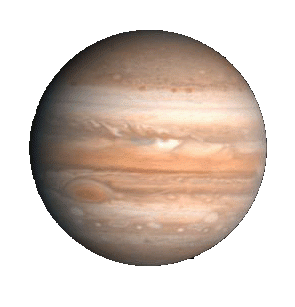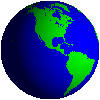Jupiter is the largest planet in the solar system. Jupiter takes about 12 years to orbit the sun and rotates in about 10 hours. This short Jupiter "day" is amazing since the planest is roughly 11 times larger than Earth in diameter.
Unlike the rocky planets, Jupiter is a ball of dense hydrogen, helium, water, nitrogen, and other gases over a tiny rocky core. Powerful winds dominate the atmosphere with criss-corssing jet streams, lightning and huge hurricane-like storms like the Great Red Spot. This storm can been raging for over 300 years and is about two times the size of Earth in diameter. The Great Red Spot can be seen on Jupiter along with four moons: Io (smallest), Europa, Callisto and Ganymede.
The planet had 39 known moons at this time and a slight ring of smoke-sized particles and dust. The planet contains 71% of the planetary matter in the solar system and so its huge gravity pulls every object towards it. In fact, most of its moons were captured rather than forming with Jupiter. Scientists watched in awe as comet Shoemaker-Levy 9 broke up and smashed into Jupiter making exposions the size of Earth.

|
Quick Facts about Jupiter | |
|
Topic |
Data |
|
Diameter |
142,984 km |
|
Density |
1.33 g/cm3 |
|
Mass |
1.900 x 1027 kg |
|
Volume |
1.377 x 1015 km3 |
|
Temperature Range |
-163° C to >-121° C |
|
Atmosphere |
Hydrogen, Helium, Methane |
|
Winds |
Up to 150 m/s |
|
Moons |
60 |
|
Average Distance from Sun |
778,330,000 km |
|
Orbital Period |
11 Years, 315 Days, 1.1 Hours |
|
Rotation |
0 Days, 9.925 Hours |
|
Tilt |
3.13° |
|
Rings |
Yes |
|
Composition |
Hydrogen and Helium |
|
Magnetic Field |
Extends 1,600,000 km |









